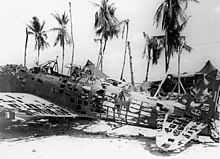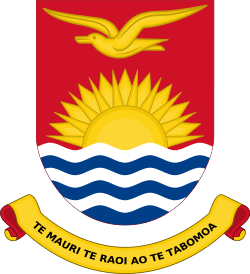Japanese occupation of the Gilbert Islands
The Japanese occupation of the Gilbert Islands was the period in the history of Kiribati between 1941 and 1945 when Imperial Japanese forces occupied Gilbert Islands during World War II, on the Pacific War theatre.
Japanese-occupied Gilbert Islands ギルバート諸島 Gilbert-shotō | |||||||||
|---|---|---|---|---|---|---|---|---|---|
| 1941-1943 | |||||||||
| Status | Military occupation by the Empire of Japan | ||||||||
| Common languages | Japanese Gilbertese | ||||||||
| Government | Military occupation | ||||||||
| Historical era | World War II | ||||||||
• Occupation of Makin | 9 December 1941 | ||||||||
• American troops land on Tarawa begins | 20 November 1943 | ||||||||
• Occupation of Ocean Island ends | 21 August 1945 | ||||||||
| |||||||||
| Today part of | |||||||||
From 1941 to 1943, Imperial Japanese Navy forces occupied the Gilbert Islands and from 1942 until 1945 Ocean Island where were the headquarters of the Gilbert and Ellice Islands colony (GIEC).
Preparations
On 29 November 1941, Operation Gi[1] (for Gilbert Islands) was decided within the Japanese 4th Fleet and departed from Truk, headquarters of the South Seas Mandate. The chosen flagship was the minelayer Okinoshima, and includes the minelayers Tsugaru, Tenyo Maru and cruiser Tokiwa, Nagata Maru, and to be escorted by Asanagi and Yūnagi of the Destroyer Division 29/Section 1. The Chitose Naval Air Group will provide the air cover of the operation. On 2 December 1941, Okinoshima received the signal "Climb Mt. Niitaka 1208", signifying that hostilities will start on 8 December. Okinoshima arrives at Jaluit and embarks a SNLF, from 51st Guards Force. She departs from Jaluit on 6 December and joins Asanagi and Yūnagi on 8 December.
Northern Gilbert Islands
The Japanese occupation of the Northern Gilbert Islands could be fall onto three periods:
- from 10 December 1941 to 16 August 1942, with a light Japanese occupation of Makin Islands (nowadays Butaritari and Makin) to the raid by the Marines. During this first period, only Butaritari was garrisoned with a seaplane base;
- from 20 August 1942 to March 1943, with a gradual increase of the expansion towards South, including Tarawa and Abemama, and also Nauru outside of the Gilberts, to become fortified places with airfields;
- the last phase, before the end of occupation, from March to the end of battle of Tarawa and battle of Makin on 23 November 1943.
On the day of their attack on Pearl Harbor, Japanese military forces onboard the minelayer Okinoshima which was serving as flagship for Admiral Kiyohide Shima in Operation Gi (the invasion of the Gilbert Islands) and had deployed from Jaluit with a Special Naval Landing Force (SNLF) embarked. From 9-10 December, Okinoshima supported the Japanese landings on Makin and on Tarawa, and on 24 December, the seizure of Abaiang.[2] The 51st Guards Force from Jaluit Atoll occupied on 10 December 1941 (local time 0045), Makin and on 11 December Little Makin, then later Abaiang and Marakei in the northern Gilbert Islands. Japanese immediately seized the New Zealand Coastwatchers of Makin.[3] Within two days, a seaplane base was built on Makin lagoon by Nagata Maru.
Few hours before Makin occupation, on 10 December 1941, the same Japanese landing military (DesDiv 29/Section 1's Asanagi and Yūnagi) visited Tarawa, where they round up the Europeans and informed them that they cannot leave the atoll without the permission of the naval commander, Kiyohide Shima. The Japanese destroyed all means of transportation and ransack the Burns Philp trading station, then departed for Makin atoll.
.jpg)
On 31 August 1942, Japanese troops occupied also Abemama. On September, some remote central and southern islands were also briefly visited or occupied (Tamana was the southernmost) especially for destroying the Coastwatchers network, headquartered on Beru[4]. On 15 September 1942, Japanese forces occupied Tarawa and began fortifying the atoll, mainly Betio islet where they built an airfield. In response, on 2 October 1942, US forces occupied the Ellice Islands and began constructing airfields on Funafuti, Nukufetau and Nanumea as a base of operations against the Japanese occupation in the Gilbert and Marshall Islands.
On 27 March 1943, a Japanese aircraft attacked the new American airfield at Funafuti for the first time.
On 6 November 1943, the United States Seventh Air Force established its forward headquarters base on Funafuti, to prepare the battle of Tarawa.[5]

Rear Admiral Keiji Shibazaki was killed on 20 November 1943, as the last commander of the Japanese 3rd Special Base Force — in garrison on the island of Betio — and of the Gilbert Islands, Nauru and Ocean Island. Admiral Carl Henry Jones (1893 - 1958) became thereafter the U.S. commander of the Gilbert Islands subarea (from 18 Dec 1943 to 1 Oct 1944), at the end of this battle.[6]
Ocean Island (オーシャン島)
On July 1941, Australia and New Zealand evacuated dependents of British Phosphate Commission employees from Ocean Island.
On 8 December 1941, a Japanese flying boat Kawanishi H6K drops six bombs on the Government Headquarters on Ocean Island. On February 1942, the Free French destroyer Le Triomphant evacuated the remaining Europeans and Chinese from Ocean Island. Japanese forces occupied the island from 26 August 1942. All but about 143-160 Banabans are deported to Nauru, Tarawa, Truk or Kosrae, until the end of World War II in 1945.[7] On 20 August 1945, the Japanese troops murdered the 150 Banabans remaining on Ocean Island. One man only, Kabunare Koura, survived the massacre. On 21 August, the Australian troops retake Ocean Island from the Japanese. Before the end of the year, the 280 Banabans who survived the war on Nauru, Tarawa, Kosrae and Truk are resettled on Rabi Island in Fiji.
Japanese Commanders
- 9 Dec 1941 - 1942, Capt. Shigetoshi Miyazaki (宮崎重敏, IJNAF) (1897-1942), commanded the Gilberts’ Operation in the initial phase
- 1942 - 17 Aug 1942, Warrant Officer Kyuzaburō Kanemitsu (d. 1942), commander in Makin Atoll, killed on Raid on Makin Island[8];
- Sep 1942 - 22 Feb 1943, Cdr. Keisuke Matsuo (松尾景輔) (b. 1890? - d. 1943), commander of the Yokosuka 6th SNLF (No. 6 Base Force, based in Kwajalein), was in command locally of the force in Tarawa;
- 22 Feb 1943 - Jul 1943, Rear Admiral Saichirō Tomonari (友成佐市郎) (b. 1887 - d. 1962), commander in Tarawa, for the Gilbert Islands, Nauru and Ocean Island;

- Sep 1943 - 20 Nov 1943, Rear Admiral Keiji Shibazaki (b. 1894 - d. 1943)
- Japanese occupation ends on the Gilbert Islands on 23 November 1943.
- Japanese occupation ends on Ocean Island on 21 August 1945.
Because of the distance between Kwajalein and Tarawa (580 nm), on 15 February 1943, the Gilbert Islands, Ocean Island and Nauru were removed from the 6th Base Force in Kwajalein and replaced under a new 3rd Special Base Force with headquarters in Betio, with Admiral Tomonari replacing Matsuo. Because of the loss of his command, Matsuo made seppuku on 2 May 1943.
See also
Bibliography
- Hoyt, Edwin P. (1979). Storm Over the Gilberts: War in the Central Pacific 1943. New York, NY: Van Nostrand Reinhold.
- Moran, Jim (2019). The Gilbert and Ellice Islands — Pacific War. Yorkshire, England: Pen & Sword Military. p. 176. ISBN 978-1-52675-119-5.
- Garrett, Jemima (1996). Island exiles. Sydney: ABC books. p. 200. ISBN 0-7333-0485-0.CS1 maint: ref=harv (link)
- Gill, G. Hermon (1957). Australia in the War of 1939–1945. Series 2 – Navy. Volume I – Royal Australian Navy, 1939–1942 (1st edition, 1957 ed.). Canberra: Australian War Memorial. Gill57.CS1 maint: ref=harv (link)
- Williams, Maslyn; Macdonald, Barrie (1985). The Phosphateers: A History of the British Phosphate Commissioners and the Christmas Island Phosphate Commission. p. 586. ISBN 0-522-84302-6.CS1 maint: ref=harv (link)
- Tanaka, Yuki (2010). Japanese Atrocities on Nauru during the Pacific War: The murder of Australians, the massacre of lepers and the ethnocide of Nauruans. Japan focus.CS1 maint: ref=harv (link)
- Viviani, Nancy (1970). Nauru, Phosphate and Political Progress. Australian National University Press. ISBN 0-7081-0765-6.CS1 maint: ref=harv (link)
References
- Rohwer, Jürgen (2005). Chronology of the War at Sea, 1939-1945: The Naval History of World War Two. US Naval Institute Press. ISBN 1-59114-119-2.
- From 5 February 1942 – 29 November 1943, Kōsō Abe was commander of the 6th Base Force at Kwajalein in the Marshall Islands. As such, he was essentially the wartime military governor of the Marshall Islands, Gilbert Islands, Nauru, Ocean Island and Wake Island in the central Pacific Ocean.
.svg.png)

